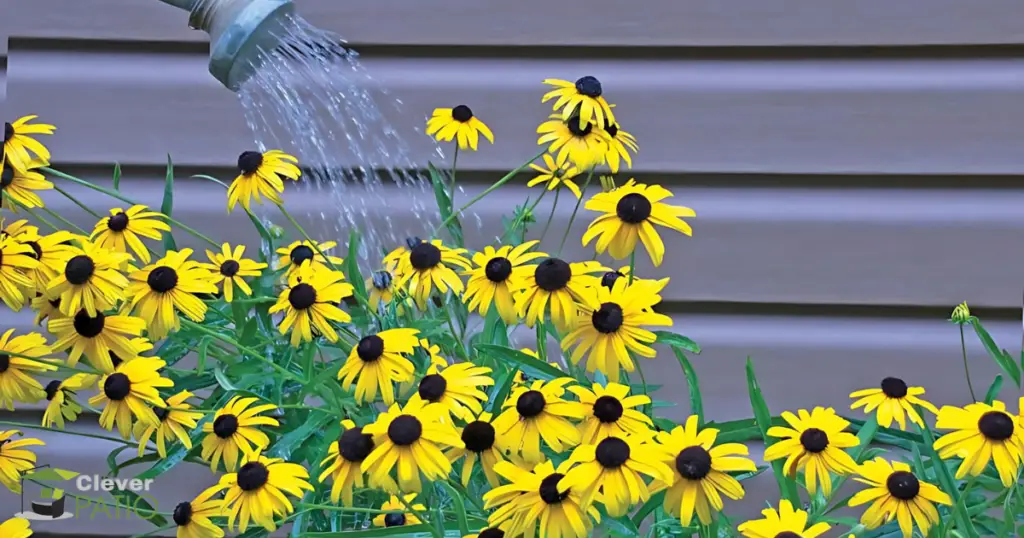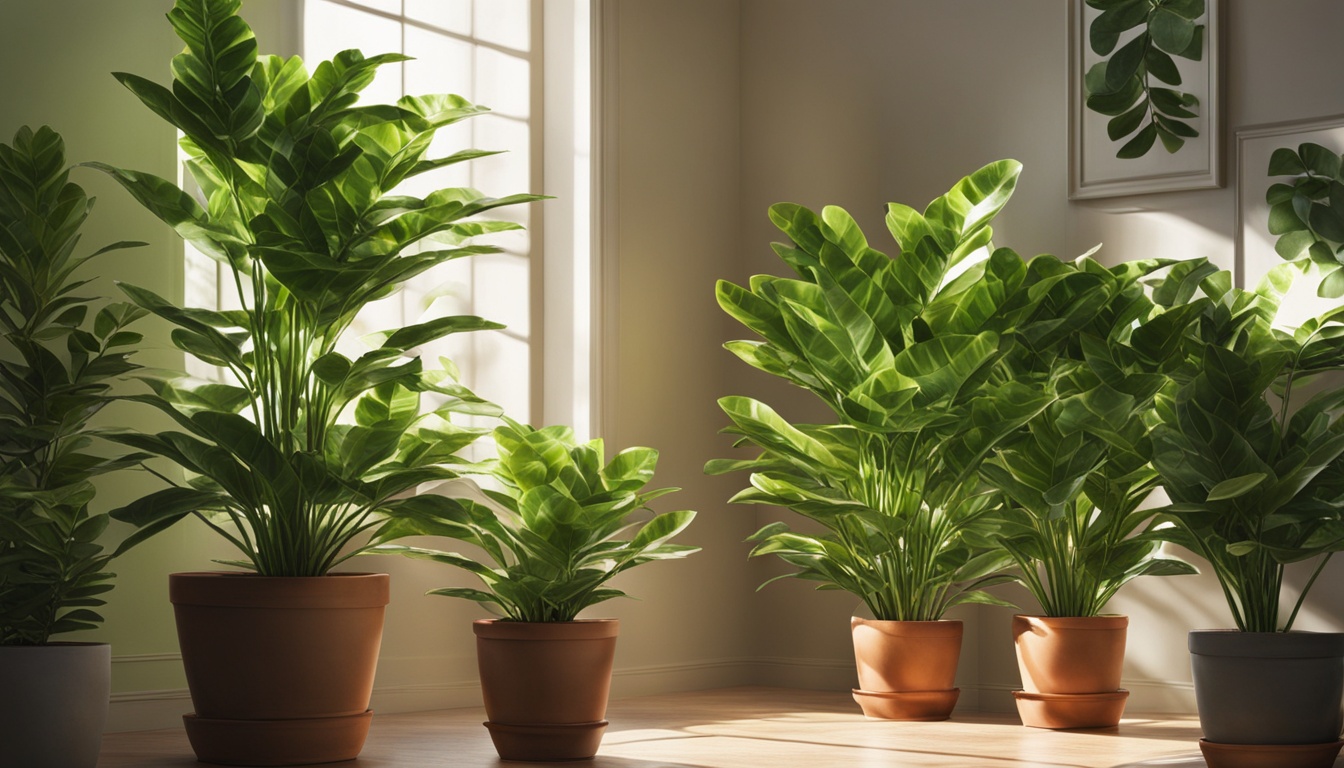Looking to brighten up your garden with vibrant, drought-resistant plants? Dive into our guide where we’ll explore 31 stunning options that will keep your garden flourishing even in the driest conditions.
Say goodbye to thirsty plants and hello to a vibrant, water-wise garden!

Hot weather can challenge even the most resilient plants, but fear not! Drought-tolerant varieties are here to save the day, thriving even under the blazing sun.
Whether you’re interested in cacti, succulents, herbs, or ornamental grasses, there’s a wealth of options for creating a lush, green garden in the heat.
We’ll break down these hardy plants into categories like cacti, succulents, herbs, ornamental grasses, vines, perennials, annuals, and shrubs, so you can find the perfect match for your garden’s needs.
Keep reading to discover these incredible plants that can turn your garden into a vibrant oasis despite the scorching temperatures!
Drought Tolerant Plants And Flowers
1. Black-Eyed Susan

This beloved perennial features cheerful, daisy-like flowers in vibrant yellow or orange that light up your summer garden.
It thrives in both heat and drought, making it a resilient choice for tough conditions. Plus, it often reseeds itself, ensuring a stunning, colorful display year after year!
2. Yarrow

This clump-forming perennial is perfect for hot climates, offering both drought tolerance and deer resistance.
It boasts clusters of delicate white or yellow flowers in the summer and thrives with minimal maintenance. Ideal for adding a touch of beauty to low-maintenance gardens!
3. Blanket Flower

Also known as gaillardia, the blanket flower is a vibrant, heat-loving plant that flaunts bright yellow or red daisy-like blooms from late spring to early fall.
It’s a low-maintenance beauty that thrives in a variety of soil types with minimal water needs.
This hardy shrub is perfect for dry climates and can even flourish at high altitudes of up to 11,000 feet. With its ability to grow into a small tree reaching up to 20 feet tall, it’s affectionately dubbed the “tree daisy.”
It prefers full sun and well-drained soil, though it can handle some shade. Just keep it away from overly wet or humid areas, and plant it on higher ground to ensure it stays healthy and vibrant.
4. Rose Campion

Rose campion is a charming perennial known for its striking pink or white flowers and lush green foliage.
It thrives in sunny spots with well-drained, dry soil. Ideal for gardeners in zones four through six, it can be a delightful addition to your garden each year.
However, if you’re in zones one through three, this plant might not be suitable for your climate.
5. Oleander

The oleander is a hardy, drought-tolerant shrub that doubles as an attractive ornamental plant.
Native to the subtropical regions of Africa and Asia, oleanders have been cherished in temperate areas for centuries due to their year-round blooms.
Thriving in full sun and enduring hot, dry conditions, oleanders adapt well to a range of soil types and require minimal maintenance once established.
They’re robust plants, virtually free from insect pests and disease issues, making them a resilient choice for your garden.
6. Verbena

For dry climates, verbena is an excellent choice, offering a vibrant range of blooming colors.
It thrives whether planted directly in the ground or in wide, shallow containers that accommodate its root system.
Water it sparingly—just enough to keep a light film on the soil surface—to avoid rot. This approach will help your verbena flourish without overwatering.
7. Zinnia

This vibrant annual, native to Mexico, dazzles with blooms in red, orange, pink, or purple all summer long.
It’s both heat and drought-tolerant, thriving in a variety of soil types while adding a splash of color to your garden.
8. California Poppy

Native to the western United States, this lively annual bursts into bright orange, yellow, or red flowers throughout spring and summer.
Once established, it needs minimal water and will reseed itself, ensuring vibrant blooms for years to come.
9. Marigold

These sunny blooms have been a favorite for centuries thanks to their low-maintenance needs and resilience in hot, dry conditions.
Available in shades of yellow, orange, or white, they typically brighten your garden from mid-summer until the first frost.
10. Portulaca

Portulaca’s dainty flowers thrive in dry, warm soil and love basking in the sun. As one of the easiest plants to cultivate, it’s a fantastic choice for beginners looking to add vibrant color to their garden with minimal fuss!
These drought-tolerant plants are low-maintenance, needing only minimal water and fertilizer to stay content. However, keep in mind that they aren’t cold-resistant, so choose your planting location and timing wisely.
Be sure to use well-drained soil for planting, as overly wet or soggy conditions can lead to root rot. With the right care, these hardy plants will thrive and bring vibrant beauty to your garden.
11. Wallflower

Wallflowers are charming, hardy plants known for their vibrant blooms and ability to tolerate various conditions.
They produce clusters of colorful flowers, often in shades of orange, yellow, red, or purple, and are great for adding a burst of color to your garden.
Wallflowers are adaptable and can thrive in both full sun and partial shade, making them a versatile choice for many garden settings.
They also handle dry spells well, though they prefer well-drained soil to prevent root rot.
12. Saguaro

This impressive cactus, native to the Sonoran Desert in Arizona and Mexico, can grow up to 40 feet tall.
It features a woody stem and produces large, stunning white flowers that bloom in the summer. Though slow-growing, its dramatic presence and beautiful blooms make it a standout choice for arid gardens.
13. Barrel Cactus

This cactus species is found across North and South America, from Canada down to Argentina.
It can grow up to 5 feet tall and boasts spines that shield it from both predators and intense heat, making it an ideal choice for hot climates.
14. Prickly Pear

This popular edible cactus is found across the Americas and is often used in Mexican cuisine as nopales or tuna fruit salad.
Its flat, oval pads are covered with spines that protect it from predators.
15. Sedum

This low-growing succulent is a perennial known for its cheerful yellow, pink, or white flowers that bloom in the summer.
Often used as ground cover, it thrives in dry soil conditions and adds vibrant color to arid or low-maintenance gardens.
16. Echeveria

These rosette-shaped succulents boast a variety of shapes and sizes, with colors ranging from deep purple to bright green or blue-gray.
They’re perfect for hot climates due to their minimal water requirements, adding a splash of striking color and texture to your garden.
17. Aloe

This well-loved succulent is not only easy to grow but also offers valuable medicinal properties.
It’s drought-tolerant and thrives in both full sun and partial shade, making it a versatile addition to any garden.
18. Agave

Native to Mexico, this large succulent can grow up to 6 feet tall. Its thick spines serve as protection from predators, making it well-suited for hot climates.
Its impressive size and sturdy defense mechanisms make it a standout choice for arid gardens.
Drought-Tolerant Herbs
19. Rosemary

This herb thrives in hot, dry climates and is commonly used both as an ornamental plant and a flavorful addition to various dishes.
It produces delicate blue flowers that bloom during the summer, adding a touch of beauty to your garden while enhancing your culinary creations.
20. Oregano

A member of the mint family, oregano is a fragrant herb that flourishes in sunny, dry conditions with well-draining soil.
It produces small pinkish-purple flowers that bloom in late summer and early fall, adding both beauty and a delightful aroma to your garden.
21. Sage

Sage is a resilient herb that’s perfect for dry, sunny climates. Known for its small purple or blue flowers that bloom in summer, it’s also valued for its flavorful leaves used in various dishes.
Often called “the wise woman’s herb” or “the herb of remembrance,” sage has a long history of being associated with wisdom and strength. The Romans even used it in their bathwater, believing it enhanced memory.
In drought conditions, sage excels, thriving as a woody perennial that can reach up to two feet tall. It features sparse foliage and delicate flowers, making it well-suited for hotter, drier environments.
For optimal growth, sage requires full sun, so plant it in a sunny spot where it can receive direct sunlight for most of the day. It can be propagated from stem or root cuttings, but be sure to space plants at least six feet apart.
This spacing helps ensure that some plants aren’t shaded by their neighbors and allows for better airflow and growth.
22. Lavender

This aromatic herb is perfect for hot, dry climates and needs minimal upkeep. With its lovely purple flowers blooming from summer to fall, lavender makes a beautiful and practical addition to any garden.
Plant lavender in a sunny spot or partial shade. It’s great as a ground cover and requires only occasional pruning to keep it tidy—just trim back some stems and leaves as needed.
The plant’s blooms will drop off early, but you can harvest them to use fresh, make into candies, or steep in boiling water for a soothing tea.
Drought Tolerant Ornamental Grasses
23. Feather Grass

Native to desert regions, this ornamental grass thrives in hot, dry climates with minimal water.
Its delicate, wispy leaves add a soft texture to the garden, while its feathery flowers provide a distinctive burst of beauty when they bloom in mid-summer.
24. Blue Grama Grass

This low-maintenance grass is highly drought-tolerant and flourishes in hot climates with well-drained soil.
Its striking blue-green foliage contrasts beautifully with other plants, and it produces charming tufts of yellow flowers in late summer.
25. Fountain Grass

This ornamental grass features a graceful, fountain-like shape with long, cascading leaves. In summer, it produces feathery pinkish-purple panicles that add a touch of elegance to your garden. It thrives with minimal water and care, making it an easy choice for low-maintenance landscapes.
The blooms will drop off early, but you can harvest them to use fresh, make into candies, or steep in boiling water to create a soothing tea.
Drought Tolerant Vines
26. Trumpet Vine

This fast-growing vine features vibrant green foliage and trumpet-shaped blooms in red, pink, or orange hues.
Its eye-catching flowers make it a stunning addition to any garden, and its drought-tolerant nature ensures it thrives in hot climates.
27. Clematis

Another beloved flowering vine, clematis boasts large, bell-shaped blooms in shades of purple, blue, or white.
It’s easy to grow and adapts well to dry conditions, requiring minimal water to thrive.
28. Morning Glory

This twining vine is adorned with charming trumpet-shaped flowers in a range of colors, including pink, purple, white, and blue.
It thrives in hot weather and needs minimal water once established, making it a resilient and colorful choice for your garden.
Drought Tolerant Shrubs
29. Russian Sage

Russian sage is a must-have for any drought-tolerant garden, and it’s also incredibly easy to grow. This hardy plant thrives in well-drained soil with good air circulation and can handle dry spells with minimal supplemental water. Its intense aroma is a bonus for many gardeners.
To keep Russian sage at its best, fertilize it every two months during spring and summer. It prefers nutrient-rich soil to help produce its aromatic oils and ensure robust growth.
Whether you’re dealing with dry conditions or just want a low-maintenance, fragrant addition to your landscape, Russian sage is a great choice.
30. Lantana

This vibrant shrub, native to Central and South America, thrives in hot temperatures and requires minimal water.
It produces stunning blooms in pink, orange, or yellow throughout the summer, drawing hummingbirds, butterflies, and other pollinators to your garden.
31. Texas Sage

This low-maintenance shrub thrives in hot climates with minimal water, growing quickly and effortlessly.
Its silver-green foliage provides a striking contrast against other plants, while its lavender flowers add a vibrant splash of color throughout the summer.
Tips for Watering Plants During a Drought
- Opt for Drought-Resistant Plants: Choose plants that are naturally adapted to dry conditions.
- Group Plants by Water Needs: Arrange plants together based on their water requirements to make watering more efficient.
- Water Deeply and Infrequently: Give plants a thorough watering less often to encourage deep root growth and minimize evaporation.
- Use Mulch: Apply mulch around plants to help retain soil moisture and reduce the need for frequent watering.
- Check Soil Moisture: Always check the soil moisture before watering to avoid overwatering.
- Employ Efficient Irrigation: Use drip systems or soaker hoses to deliver water directly to the plant roots with minimal waste.
- Consider Recycled Water: When possible, use recycled water for irrigation to conserve resources.
- Install Rainwater Harvesting Systems: Collect rainwater from roofs and hardscapes to supplement your garden’s water supply.
- Utilize Native Plants: Opt for native plants that are well-suited to your local climate and require less water.
- Replace Lawns with Groundcovers: Use drought-tolerant groundcovers instead of traditional lawns to reduce watering needs.
- Cover Soil with Mulch or Compost: Reduce evaporation loss by covering exposed soil with mulch or compost.
- Water Early in the Morning: Water plants in the early morning when temperatures are cooler and humidity is higher to minimize evaporation.
These tips can help you manage water use effectively while keeping your garden healthy during dry periods.



